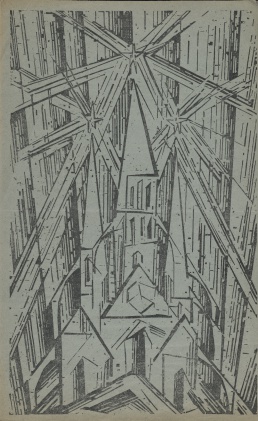Difference between revisions of "Bauhaus"
| Line 1: | Line 1: | ||
| + | [[Image:Gropius_Walter_Programm_des_Staatlichen_Bauhauses_in_Weimar_1919.jpg|thumb|258px|Walter Gropius, ''Programm des Staatlichen Bauhauses in Weimar'', Apr 1919. 4 p., 32 cm. [[Media:Gropius_Walter_Programm_des_Staatlichen_Bauhauses_in_Weimar_1919.pdf|Download]] (22 MB). [http://brbl-dl.library.yale.edu/vufind/Record/3445408 Source].]] | ||
The '''Bauhaus''' was founded in 1919 in the city of Weimar by German architect Walter Gropius. Its core objective was a radical concept: to reimagine the material world to reflect the unity of all the arts. Gropius explained this vision for a union of art and design in the ''Programm des Staatlichen Bauhauses Weimar'' (1919), which described a utopian craft guild combining architecture, sculpture, and painting into a single creative expression. Gropius developed a craft-based curriculum that would turn out artisans and designers capable of creating useful and beautiful objects appropriate to this new system of living. | The '''Bauhaus''' was founded in 1919 in the city of Weimar by German architect Walter Gropius. Its core objective was a radical concept: to reimagine the material world to reflect the unity of all the arts. Gropius explained this vision for a union of art and design in the ''Programm des Staatlichen Bauhauses Weimar'' (1919), which described a utopian craft guild combining architecture, sculpture, and painting into a single creative expression. Gropius developed a craft-based curriculum that would turn out artisans and designers capable of creating useful and beautiful objects appropriate to this new system of living. | ||
| Line 72: | Line 73: | ||
[[Image:Staatliches Bauhaus Weimar 1919-1923.jpg|thumb|258px|''Staatliches Bauhaus Weimar, 1919-1923'', 1923. [http://bibliothequekandinsky.centrepompidou.fr/imagesbk/FondsKandinskyL498/M5050_X0031_LKA_L498.pdf Download] (325 MB).]] | [[Image:Staatliches Bauhaus Weimar 1919-1923.jpg|thumb|258px|''Staatliches Bauhaus Weimar, 1919-1923'', 1923. [http://bibliothequekandinsky.centrepompidou.fr/imagesbk/FondsKandinskyL498/M5050_X0031_LKA_L498.pdf Download] (325 MB).]] | ||
(in German unless noted) | (in German unless noted) | ||
| − | * ''Programm des Staatlichen Bauhauses Weimar'', Weimar, 1919. | + | * Walter Gropius, ''[[Media:Gropius_Walter_Programm_des_Staatlichen_Bauhauses_in_Weimar_1919.pdf|Programm des Staatlichen Bauhauses Weimar]]'', Weimar, April 1919, 4 pp. |
| + | ** [[Media:Gropius_Walter_1919_1981_Program_of_the_Staatliche_Bauhaus_in_Weimar.pdf|"Program of the Staatliche Bauhaus in Weimar"]], in Hans M. Wingler, ''The Bauhaus : Weimar, Dessau, Berlin, Chicago'', MIT Press, 1981, pp 31-33. (in English) | ||
* ''Satzungen des Staatlichen Bauhauses zu Weimar'', Weimar, 1921. | * ''Satzungen des Staatlichen Bauhauses zu Weimar'', Weimar, 1921. | ||
* ''Die Bauhausbühne. Leitung: Lothar Schreyer. Erste Mitteilung'', Weimar, 1922. | * ''Die Bauhausbühne. Leitung: Lothar Schreyer. Erste Mitteilung'', Weimar, 1922. | ||
| Line 96: | Line 98: | ||
* 4. Bauhaus-Kolloquium Weimar vom 24. - 26. Juni 1986, "Der wissenschaftlich-technische Fortschritt und die sozial-kulturellen Funktionen von Architektur und industrieller Formgestaltung in unserer Epoche". [http://e-pub.uni-weimar.de/portal/Bauhaus-Kolloquium-1986/] | * 4. Bauhaus-Kolloquium Weimar vom 24. - 26. Juni 1986, "Der wissenschaftlich-technische Fortschritt und die sozial-kulturellen Funktionen von Architektur und industrieller Formgestaltung in unserer Epoche". [http://e-pub.uni-weimar.de/portal/Bauhaus-Kolloquium-1986/] | ||
* later editions: [http://www.uni-weimar.de/cms/en/architektur/atheo/bauhaus-kolloquium.html] | * later editions: [http://www.uni-weimar.de/cms/en/architektur/atheo/bauhaus-kolloquium.html] | ||
| + | |||
| + | ==Documentaries== | ||
| + | * [http://www.youtube.com/watch?v=wZOqTFtEHAw Bauhaus: The Face of the Twentieth Century], dir. Frank Whitford, 1994. [http://www.youtube.com/watch?v=nyEDZD0rl6U Part 2], [http://www.youtube.com/watch?v=Yq8AnYL5-30 Part 3]. | ||
==See also== | ==See also== | ||
| Line 104: | Line 109: | ||
* http://www.bauhaus-dessau.de | * http://www.bauhaus-dessau.de | ||
* [http://bauhaus-online.de Bauhaus online] (in German) | * [http://bauhaus-online.de Bauhaus online] (in German) | ||
| + | * http://www.baunet-info.com/ | ||
* http://www.avantgarde-museum.com/en/museum/collection/4446-BAUHAUS/ | * http://www.avantgarde-museum.com/en/museum/collection/4446-BAUHAUS/ | ||
| − | |||
| − | |||
| − | |||
| − | |||
* [http://en.wikipedia.org/wiki/Bauhaus Bauhaus at Wikipedia] | * [http://en.wikipedia.org/wiki/Bauhaus Bauhaus at Wikipedia] | ||
* http://www.designers-books.com/utopia-dokumente-der-wirklichkeit-i-und-ii-1921-bauhaus/ | * http://www.designers-books.com/utopia-dokumente-der-wirklichkeit-i-und-ii-1921-bauhaus/ | ||
Revision as of 22:47, 17 August 2014
The Bauhaus was founded in 1919 in the city of Weimar by German architect Walter Gropius. Its core objective was a radical concept: to reimagine the material world to reflect the unity of all the arts. Gropius explained this vision for a union of art and design in the Programm des Staatlichen Bauhauses Weimar (1919), which described a utopian craft guild combining architecture, sculpture, and painting into a single creative expression. Gropius developed a craft-based curriculum that would turn out artisans and designers capable of creating useful and beautiful objects appropriate to this new system of living.
The Bauhaus combined elements of both fine arts and design education. The curriculum commenced with a preliminary course that immersed the students, who came from a diverse range of social and educational backgrounds, in the study of materials, color theory, and formal relationships in preparation for more specialized studies. This preliminary course was often taught by visual artists, including Paul Klee, Wassily Kandinsky, Josef Albers, and László Moholy-Nagy, among others. The school operated until 1933. [1]
Contents
Books
| The following nine PDFs are linked from Bibliothèque Kandinsky which published them online on an unknown date. Follow this link to explore the respective entries on its website. This is an important milestone in the digitalization of essential but hard-to-get art publications for the public use and we would like to express our gratitude and appreciation. <3 ! The whole set of these high-quality digital facsimiles is about 1 GB large, if anyone feels like starting a torrent to relieve bandwidth of the library let us know and we'll include your link here expressly. (17 Aug 2014) |
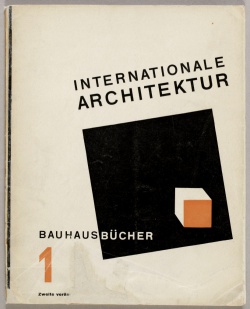 1. Walter Gropius (ed.), Internationale Architektur, 1925. 111 p., 23 cm. Download (111 MB). |
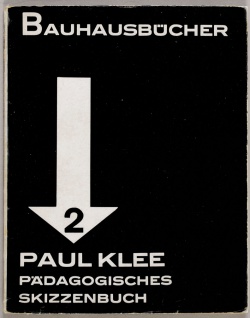 2. Paul Klee, Pädagogisches Skizzenbuch, 1925. 50 p., 23 cm. Download (33 MB). |
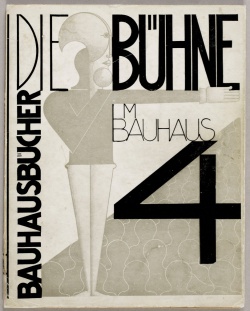 4. Die Bühne im Bauhaus, 1924. 84 p., 23 cm. Download (72 MB). |
 7. Neue Arbeiten der Bauhauswerkstätten, 1925. 115 p., 23 cm. Download (118 MB). |
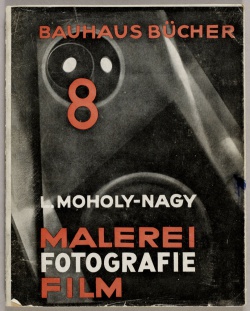 8. L. Moholy-Nagy, Malerei, Fotografie, Film, 2nd ed., 1927. 140 p., 23 cm. Download (131 MB). |
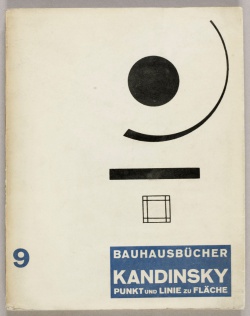 9. Kandinsky, Punkt und Linie zu Fläche: Beitrag zur Analyse der malerischen Elemente, 1926. 190 p., 23 cm. Download (134 MB). |
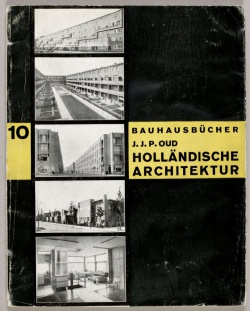 10. J.J.P. Oud, Holländische Architektur, 1929. 107 p., 23 cm. Download (89 MB). |
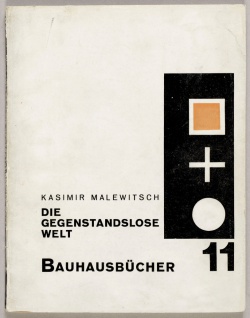 11. Kasimir Malewitsch, Die gegenstandslose Welt, 1927. 104 p., 24 cm. Download (84 MB). |
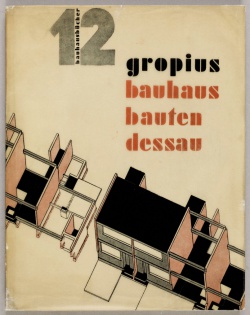 12. Walter Gropius, Bauhausbauten Dessau, 1930. 221 p., 23 cm. Download (222 MB). |
- 1. Walter Gropius, Internationale Architektur, Munich: Albert Langen, 1925, 111 pp.
- 2. Paul Klee, Pädagogisches Skizzenbuch, Munich: Albert Langen, 1925, 50 pp.
- Pedagogical Sketchbook, intro. & trans. Sibyl Moholy-Nagy, New York: Frederick A. Praeger, 1953, 65 pp; 1960. (in English)
- Παιδαγωγικό Σημειωματάριο, trans. Β. Λαγοπούλου, 1976. (in Greek)
- Pedagogikheskie eskizy, trans. N. Druzhkovoy, 2005. (in Russian)
- 3. Adolf Meyer (ed.), Ein Versuchshaus des Bauhauses in Weimar, Munich: Albert Langen, 1924, 78 pp.
- 4. Die Bühne am Bauhaus, Munich: Albert Langen, 1925, 84 pp.
- The Theater of the Bauhaus, trans. Arthur S. Wensinger, Middletown, Conn.: Wesleyan University Press, 1961. (in English)
- 5. Piet Mondrian, Neue Gestaltung, Neoplastizimus, Nieuwe Beelding, Munich: Albert Langen, 1925, 66 pp.
- 6. Theo van Doesburg, Grundbegriffe der neuen gestaltenden Kunst, Munich: Albert Langen, 1925.
- Principles of Neo-Plastic Art, London: Lund Humphries, 1969. (in English)
- 7. Walter Gropius (ed.), Neue Arbeiten der Bauhauswerkstäffen, Munich: Albert Langen, 1925, 115 pp.
- 8. L. Moholy-Nagy, Malerei, Fotografie, Film, Munich: Albert Langen, 1925, 115 pp; 2nd ed., 1927, 140 pp. Incl. "Dynamik der Gross-Stadt", pp 116-129.
- Painting Photography Film, trans. Janet Seligman, London: Lund Humphries, 1969. (in English)
- 9. Kandinsky, Punkt und Linie zu Fläche: Beitrag zur Analyse der malerischen Elemente, Munich: Albert Langen, 1926, 190 pp.
- 10. J.J.P. Oud, Holländische Architektur, Munich: Albert Langen, 1929, 107 pp.
- 11. Kasimir Malewitsch, Die gegenstandslose Welt, Munich: Albert Langen, 1927, 104 pp.
- 12. Walter Gropius, Bauhausbauten Dessau, Munich: Albert Langen, 1930, 221 pp.
- 13. Albert Gleizes, Kubismus, Munich: Albert Langen, 1928, 101 pp.
- 14. László Moholy-Nagy, Von Material zur Architektur, Munich: Albert Langen, 1929, 241 pp; facsimile repr., Mainz and Berlin: Florian Kupferberg, 1968, 251 pp.
- The New Vision: From Material to Architecture, trans. Daphne M. Hoffman, New York: Breuer Warren and Putnam, 1930; exp.rev.ed. as The New Vision and Abstract of an Artist, New York: George Wittenborn, 1947. (in English)
Journal
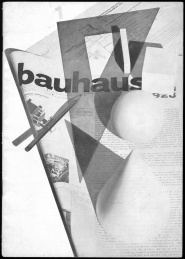 bauhaus: zeitschrift für bau und gestaltung 2:1 (Feb 1928). Download. |
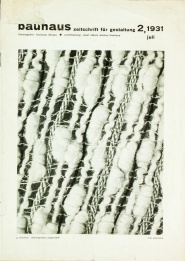 bauhaus: zeitschrift für gestaltung 2 (Jul 1931). Download. |
The above PDFs are sourced from Baunet Reader.
- bauhaus, zeitschrift für gestaltung, eds. Walter Gropius and Laszlo Moholy-Nagy, 1926-28, Ernst Kallai, 1928-30, 14 issues, Dessau, 1926-31; repr., Nendeln: Klaus Reprint, 1977.
Other publications
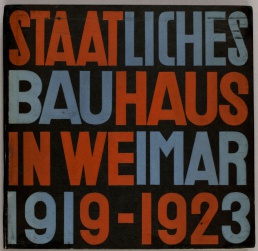
(in German unless noted)
- Walter Gropius, Programm des Staatlichen Bauhauses Weimar, Weimar, April 1919, 4 pp.
- "Program of the Staatliche Bauhaus in Weimar", in Hans M. Wingler, The Bauhaus : Weimar, Dessau, Berlin, Chicago, MIT Press, 1981, pp 31-33. (in English)
- Satzungen des Staatlichen Bauhauses zu Weimar, Weimar, 1921.
- Die Bauhausbühne. Leitung: Lothar Schreyer. Erste Mitteilung, Weimar, 1922.
- Neue Europäische Graphik 1921-1923, Potsdam: Müller 8, 1923.
- Staatliches Bauhaus Weimar, 1919-1923, Weimar and Munich: Bauhausverlag, 1923, 225 pp.
- Pressestimmen für das Staatliche Bauhaus Weimar, Weimar, 1924; repr., Nendeln: Klaus Reprint, 1980.
- Walter Gropius, Die bisherige und zukünftige Arbeit des Staatlichen Bauhauses Weimar, Weimar, 1924.
- A. Bodenthal, bauhaus dessau - hochschule für gestaltung, Dessau, 1928.
Literature
- Walter Gropius, The New Architecture and the Bauhaus, trans. P. Morton Shand, London: Faber and Faber, 1935; MIT Press, 1965. (in English). Translated from the manuscript in German entitled Die neue Architektur und das Bauhaus. Grundzüge und Entwicklung einer Konzeption.
- Herbert Bayer, Walter Gropius, Ise Gropius (eds.), Bauhaus 1919–1928, New York: Museum of Modern Art, 1938, 224 pp. (in English)
- Éva Forgács, The Bauhaus Idea and Bauhaus Politics, Central European University Press, 1995. (in English)
- Margret Kentgens-Craig, The Bauhaus and America: First Contacts, 1919-1936, MIT Press, 1999, 283 pp. (in English)
- Tom Wolfe, From Bauhaus to Our House, Picador, 2009. (in English)
- Peder Anker, From Bauhaus to Eco-House: A History of Ecological Design, 2010. (in English)
- Bibliography
Weimar symposia
- 1. Bauhaus-Kolloquium Weimar vom 27. - 29.10. 1976, "50 Jahre Bauhaus Dessau". [2]
- 2. Bauhaus-Kolloquium Weimar vom 27. - 29.06. 1979, "60 Jahre Gründung Bauhaus". [3]
- 3. Bauhaus-Kolloquium Weimar vom 5. bis 7. Juli 1983, "Das Bauhauserbe und die gegenwärtige Entwicklung der Architektur : zum 100. Geburtstag von Walter Gropius [4]
- 4. Bauhaus-Kolloquium Weimar vom 24. - 26. Juni 1986, "Der wissenschaftlich-technische Fortschritt und die sozial-kulturellen Funktionen von Architektur und industrieller Formgestaltung in unserer Epoche". [5]
- later editions: [6]
Documentaries
- Bauhaus: The Face of the Twentieth Century, dir. Frank Whitford, 1994. Part 2, Part 3.
See also
Links
- http://www.bauhaus-dessau.de
- Bauhaus online (in German)
- http://www.baunet-info.com/
- http://www.avantgarde-museum.com/en/museum/collection/4446-BAUHAUS/
- Bauhaus at Wikipedia
- http://www.designers-books.com/utopia-dokumente-der-wirklichkeit-i-und-ii-1921-bauhaus/
| Avant-garde and modernist magazines | ||
|---|---|---|
|
Poesia (1905-09, 1920), Der Sturm (1910-32), Blast (1914-15), The Egoist (1914-19), The Little Review (1914-29), 291 (1915-16), MA (1916-25), De Stijl (1917-20, 1921-32), Dada (1917-21), Noi (1917-25), 391 (1917-24), Zenit (1921-26), Broom (1921-24), Veshch/Gegenstand/Objet (1922), Die Form (1922, 1925-35), Contimporanul (1922-32), Secession (1922-24), Klaxon (1922-23), Merz (1923-32), LEF (1923-25), G (1923-26), Irradiador (1923), Sovremennaya architektura (1926-30), Novyi LEF (1927-29), ReD (1927-31), Close Up (1927-33), transition (1927-38). | ||
| Full list | ||
|---|---|---|
|
Entretiens politiques et littéraires (1890-93), Moderní revue (1894-1925), Volné směry (1897-1948), Mir iskusstva (1898-1904), Vesy (1904-09), Poesia (1905-09, 1920), Zolotoe runo (1906-10), The Mask (1908-29), Apollon (1909-17), Ukraïnska khata (1909-14), Der Sturm (1910-32), Thalia (1910-13), Rhythm (1911-13), Trudy i dni (1912), Simbolul (1912), The Glebe (1913-14), Ocharovannyi strannik (1913-16), Revolution (1913), Blast (1914-15), The Little Review (1914-29), Futuristy (1914), Zeit-Echo (1914-17), The Egoist (1914-19), L'Élan (1915-16), 291 (1915-16), Orpheu (1915), La Balza futurista (1915), MA (1916-25), SIC (1916-19), flamman (1916-21), The Blindman (1917), Nord-Sud (1917-18), De Stijl (1917-20, 1921-32), Dada (1917-21), Klingen (1917-20, 1942), Noi (1917-25), 391 (1917-24), Modernisme et compréhension (1917), Anarkhiia (1917-18), Iskusstvo kommuny (1918-19), Formiści (1919-21), S4N (1919-25), La Cité (1919-35), Aujourd'hui (1919), Exlex (1919-20), L'Esprit nouveau (1920-25), Orfeus (1920-21), Action (1920-22), Proverbe (1920-22), Ça ira (1920-23), Zenit (1921-26), Kinofon (1921-22), Het Overzicht (1921-25), Jednodńuwka futurystuw (1921), Nowa sztuka (1921-22), Broom (1921-24), Život (1921-48), Creación (1921-24), Jar-Ptitza (1921-26), New York Dada (1921), Aventure (1921-22), Spolokhi (1921-23), Gargoyle (1921-22), Veshch/Gegenstand/Objet (1922), Kino-fot (1922-23), Le Coeur à barbe (1922), Die Form (1922, 1925-35), 7 Arts (1922-28), Manomètre (1922-28), Ultra (1922), Út (1922-25), Dada-Jok (1922), Dada Tank (1922), Dada Jazz (1922), Mécano (1922-23), Contimporanul (1922-32), Zwrotnica (1922-23, 1926-27), Secession (1922-24), Stavba (1922-38), Gostinitsa dlya puteshestvuyuschih v prekrasnom (1922-24), Putevi (1922-24), Klaxon (1922-23), Akasztott Ember (1922-23), MSS (1922-23), Perevoz Dada (1922-49), Egység (1922-24), L'Architecture vivante (1923-33), Merz (1923-32), LEF (1923-25), G (1923-26), The Next Call (1923-26), Russkoye iskusstvo (1923), Disk (1923-25), Irradiador (1923), Surréalisme (1924), Almanach Nowej Sztuki (1924-25), La Révolution surréaliste (1924-29), Blok (1924-26), Pásmo (1924-26), DAV (1924-37), Bulletin de l'Effort moderne (1924-27), ABC (1924-28), CAP (1924-28), Athena (1924-25), Punct (1924-25), 75HP (1924), Le Tour de Babel (1925), Periszkop (1925-26), Integral (1925-28), Praesens (1926, 1930), Sovremennaya architektura (1926-30), bauhaus (1926-31), Das neue Frankfurt (1926-31), L'Art cinématographique (1926-31), Dokumentum (1926-27), Kritisk Revy (1926-28), Novyi LEF (1927-29), i 10 (1927-29), Nova generatsiia (1927-30), ReD (1927-31), Dźwignia (1927-28), Tank (1927-28), Close Up (1927-33), Horizont (1927-32), transition (1927-38), Discontinuité (1928), Munka (1928-39), Quosego (1928-29), Urmuz (1928), Unu (1928-32), Revista de Antropofagia (1928-29), 50 u Evropi (1928-29), Documents (1929-30), L'Art Contemporain - Sztuka Współczesna (1929-30), Adam (1929-40), Art concret (1930), Zvěrokruh (1930), Alge (1930-31), Le Surréalisme au service de la révolution (1930-33), Levá fronta (1930-33), Kvart (1930-37, 1945-49), Nová Bratislava (1931-32), Linja (1931-33), Spektrum (1931-33), Nadrealizam danas i ovde (1931-32), Ulise (1932-33), Die neue Stadt (1932-33), Mouvement (1933), PLAN (1933-36), Karavan (1934-35), Ekran (1934), Axis (1935-37), Acéphale (1936-39), Telehor (1936), aka (1937-38), Plastique (1937-39), Plus (1938-39), Les Réverbères (1938-39). | ||
